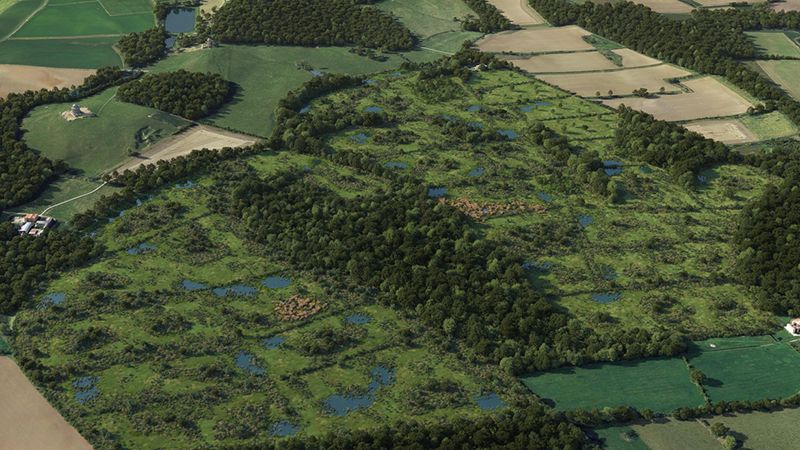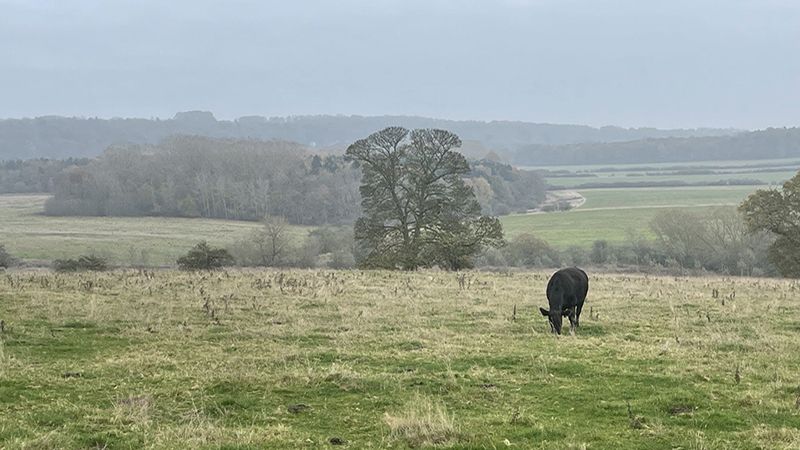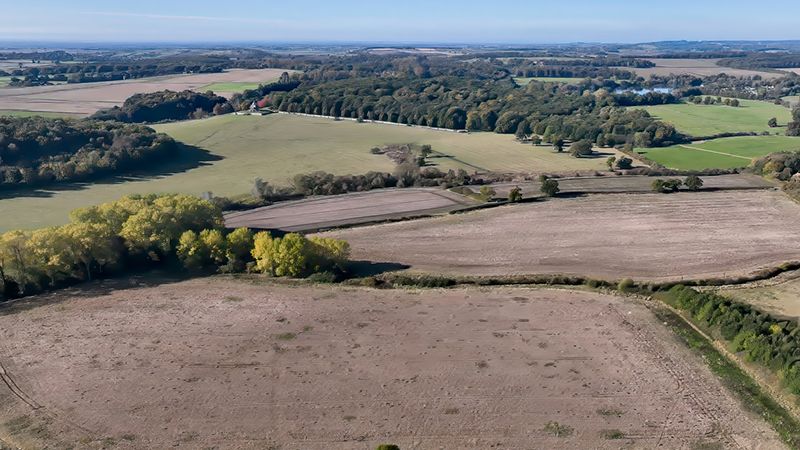Warm coats and walking boots were the order of the day when the Castle Howard estate – set against the picturesque backdrop of a misty North Yorkshire countryside – hosted journalists to talk about a new rewilding project they’re embarking on with the backing of the Environment Bank.
The Bog Hall Habitat Bank, as the site will become known, is designed to provide high-integrity ‘nature shares’ for businesses to purchase, contributing to nature restoration. The project is set to focus on restoring low-yielding agricultural land, which the landowner, the Rt. Hon. Nicolas Howard, described as “flogged within an inch of its life” due to frequent pesticide and insecticide use and intensive farming over many years.
“As a child, I was very used to the sound of birds and bees, and so on. But, over the last 60 years, I have seen the decline in what we might now call ‘natural capital’ throughout the estate,” he told guests before a tour of the site.
“There are much fewer insects, and, as a result, fewer birds here than there used to be. And, because there are fewer birds, they don’t spread seeds in the way they used to. So, we’ve seen a real decline in nature here, and, increasingly, I’ve been looking for something that we could do in some form of nature restoration project.”
Bog Hall Habitat Bank
Viewing the site from the back of an elevated trailer, you get a real sense of the scale of the project. Roughly 440 acres are set to be restored and rewilded, and, over the next 30 years, the Environment Bank will work with the Castle Howard estate to transform this arable land into a mosaic of newly created grassland, shrubland, ponds and reedbeds, while enhancing streams, ditches and woodlands. It will also include the introduction of sustainable grazing livestock, rewilding iconic species like beavers and seeding local plant species to attract rare native birds back to the area, such as turtle doves.
The project is expected to generate a nearly 200% biodiversity uplift and sequester more than 30,000 tonnes of carbon dioxide equivalent over 30 years. Additional ecological benefits include a 250% increase in bat numbers due to more insects; an increase in flowering plant diversity by 60%, leading to a 140% rise in bees and butterflies; and an increase in floral diversity by 54%.

What are ‘nature shares’?
According to Environment Bank, to become truly nature-positive, businesses must go beyond simply reducing further impact and invest in restoring biodiversity that has already been lost.
This is where ‘nature shares’ come in, offering what is described as a high-integrity solution that provides businesses with a mechanism to achieve their nature-positive targets.
Right now, Environment Bank is engaging primarily with businesses in the food and agricultural sector, including food manufacturers and supermarkets, as well as corporates from other sectors who – while less directly connected to tangible resources – are “committed to taking meaningful action toward nature-positive and sustainability goals”. By purchasing nature shares, these organisations “can secure a stake in the biodiversity uplifts this project is generating”, asserted Emma Toovey, Environment Bank’s chief ecology officer.
Gresham House has invested an initial £240m to forward-fund the creation of a nationwide network of ‘Habitat Banks’ for the voluntary and regulative biodiversity/nature markets, of which Castle Howard is one.
Comparison with carbon credits
Although this sounds like it will act similarly to a carbon credit, a market mired in controversy in recent years when projects were found to overestimate their impacts, Toovey assured that nature shares are governed by a more robust integrity framework.
“We’ve underpinned all of our projects with the Biodiversity Net Gain (BNG) compliance regime, set out by the UK government in the Environment Act 2021. This addresses a lot of the governance issues that have arisen with things like the carbon credit market, creating a level playing field by categorising every different type of habitat and figuring out what is the most valuable down to the least valuable. This means that if a company builds on a particular site and wants to offset its biodiversity impact, then it can only trade like-for-like or better.”
In that sense, Toovey said she didn’t like the comparison with carbon credits and offsets: “All of this is rigorously managed through the BNG regime in the voluntary space. A project like this can be used for offsetting, but only when it can meet those BNG rules: you know exactly where the loss is, you can define it, you can measure it and you know exactly how to compensate for that somewhere else. If you can’t do that, then it’s not offsetting.
“A lot of the opportunity in natural capital is actually around nature-positive investment. It’s about organisations that are seeking to understand and measure their impacts in their value chains, and want to do something about it.”
Although the BNG regime only covers the measurement and management of habitats, Toovey said she anticipates that it will evolve to include monitoring the influx of animal and invertebrate species that the biodiversity uplift is expected to bring. To that end, the Bog Hall site will make use of technology such as drone monitoring and bioacoustic equipment to track progress and stay ahead of the curve, offering ‘BNG +’ – added additionality that enhances the investment proposition.

‘Good governance costs money’
Over the next 30 years, the Bog Hall Habitat Bank project is expected to generate a revenue of £30m – a far cry from its current profitability.
“If all things went well, you’d average £300 to £500 per hectare. But that was only one in every three years. All the other years would be a struggle – there would be a lot of crop failures, and then you have to factor in the cost of maintenance and the risk of uncertainty, so sometimes, you’d lose money. All the while, you’re degrading the land. So, on this land, the case for this project was very clear,” said Guy Thallon, head of natural environment at the Castle Howard Estate.
“If we weren’t going down the route of working with Environment Bank, we would probably be putting it into some Environmental Land Management Sustainable Farming Incentive scheme. But that’s only going to be relevant to farming, rather than to nature restoration. The scalability of the project with Environment Bank is one of the big advantages, along with that long timeframe.”
However, a project at this scale ultimately still has maintenance costs. But, Toovey says good governance costs money – one of the largest costs on the balance sheet.
“Paying landowners fairly to look after the land for 30 years, that’s really important. But also, we need third-party oversight. We annually survey and collect data, and have to present and demonstrate transparently that what we promised, we’re actually delivering on. That legal governance that wraps around it, there’s quite a big administrative burden around that, but without that, the whole thing falls apart because you lose the integrity of it.
“We’re also building in quite a lot of contingency. We’re in a changing climate, and we don’t actually know what the world will look like in 15 years, but we want the project to succeed, so we have quite a lot of capital works contingency in there because we know we may have to intervene. Plus, there’s a lot of long-term maintenance involved. But that cost stack is so crucial to the success of the market. And I know that people probably think that it sounds a lot, but actually, it’s 30 years of looking after something that’s important. What we don’t want is a race to the bottom.”
From the Environment Bank’s perspective, while their focus in the short term is to take the Castle Howard nature shares project to market and prove that the concept works, Toovey explained if the project is successful, there could be opportunities to venture into Europe and potentially have a project on the continent in the future.
Last year’s State of Nature report concluded the UK is “one of the most nature-depleted countries on Earth”, with one in six species at risk of being lost, leading to Friends of the Earth’s Paul de Zylva declaring the UK a “hostile environment” for wildlife. But, with initiatives like this beginning to become more mainstream, and signs that the government is stepping up its support with the launch of integrity principles for carbon and nature markets, perhaps the tide is turning.








